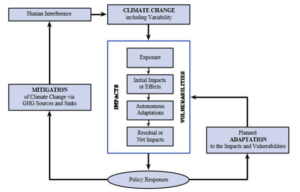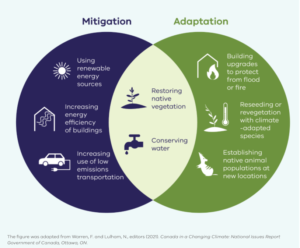The Intergovernmental Panel on Climate Change (IPCC) defines mitigation as “human intervention to reduce the sources or enhance the sinks of greenhouse gases (GHG)”, while adaptation involves adjustments in ecological, social, or economic systems in response to actual or expected climatic stimuli and their effects or impacts. It refers to changes in processes, practices, and structures to moderate potential damages or to benefit from opportunities associated with climate change. In human systems, adaptation seeks to mitigate or avoid harm or exploit beneficial opportunities” (IPCC AR5).
While mitigation is often well understood, adaptation is conceptually more difficult to grasp. According to the definition of Thornton & Manasfi (2010) [1], adaptation is a set of processes that develop in response to a multitude of social and environmental forces operating at local, regional, national, international and planetary scales. Adaptive capacity is thus the ability of human groups to adapt successfully to actual or expected environmental changes and their effects (especially those resulting from climate change). Mitigation reduces all impacts (positive and negative) of climate change and thus reduces adaptation challenges. Adaptation, on the other hand, is selective, aiming to take advantage of positive impacts and reduce negative ones (Goklany, 2005) [2].

Flowchart for understanding the terms Mitigation to Climate Change and Adaptation to Climate Change (Source: IPCC, 2001).
Both adaptation and mitigation are policies aiming to address climate change and to increase resilience to future changes. Therefore, it is reasonable to integrate both into the broader framework of sustainable development.

Schematic description of the synergy of Adaptation and Mitigation concepts to protect the Earth system and living beings from climate change (Source: Canada in a Changing Climate: National Issues Report).
Understanding the association of human activities with climate change is critical to effectively implementing mitigation and adaptation strategies.
There are plenty of simple everyday activities that contribute to greenhouse gas emissions. For example, travel choices or energy related decisions for heating, increase each citizen’s carbon footprint – the total amount of greenhouse gases emitted by their activities.
[ The Lifestyletest tool, developed within the PSLifestyle project, is an online tool that calculates the individual environmental impact (carbon footprint) and suggests a personalized action plan for a more sustainable lifestyle. ]
Globally, most industrialized countries have committed, by signing the United Nations Framework Convention on Climate Change (UNFCCC)[3] and the Paris Agreement[4], to adopt national policies to reduce greenhouse gas total emissions and to take corresponding measures for adaptation to climate change. However, due to time lag in the global climate system, greenhouse gas mitigation efforts set out in the Paris Agreement may hold the rise in global average temperature below 2°C with respect to pre-industrial levels, only as long as the pathway towards climate neutrality, i.e. zero net greenhouse gas emissions (IPCC AR6), is accelerated. According to the 6th assessment report of the IPCC (IPCC AR6), even if the global commitments undertaken by the Parties to the Paris Agreement to reduce greenhouse gas emissions are effectively achieved, global temperature increase will exceed 1.5°C from the average value in the pre-industrial period.
Climate change is therefore expected to continue, necessitating processes to reduce the adverse consequences on the environment and ecosystems, the economy and society, the human health and well-being.
Despite the initial focus on mitigation, the importance of adaptation is increasingly recognized due to the fact that some levels of climate change are inherently inevitable and, furthermore, because uncertainties about the effectiveness of mitigation policies require the improvement of adaptation capacities (Sharafi, 2021)[5].
[1] Thornton T, Manasfi N (2010). Adaptation–genuine and spurious: demystifying adaptation processes in relation to climate change. Environment and Society 1:132–155.
[2] Goklany I.M. (2005). A climate policy for the short and medium term: Stabilization or adaptation? Energy and Environment 16: 667 – 680.
[3] The United Nations Framework Convention on Climate Change (UNFCCC) was signed by 154 countries and the European Union in June 1992 in Rio, during the Summit on Environment and Development. Greece ratified the Convention with Law 2205/1994 (Government Gazette 60/A/15-4-1994).
[4] The Paris Agreement was adopted in 2015 by the 21st Conference of the Parties (COP21) within the framework of the UN Framework Convention on Climate Change and is the first multilateral international climate change treaty that aims to stabilize the long-term rise in global temperature to below 2 degrees Celsius above pre-industrial levels, promoting stabilization of the rise below 1.5 degrees , as this will significantly reduce the risks from the effects of climate change. Its Parties have a legally binding obligation to implement national measures to reduce greenhouse gas emissions in order to achieve the goals of their National Determined Contributions (NDCs). Greece ratified the Agreement with Law 4426/2016 (Government Gazette 187/A/06-10-2016).
[5] Sharifi A. (2021): Co-benefits and synergies between urban climate change mitigation and adaptation measures: A literature review. Science of the Total Environment 750, 141642. doi:10.1016/j.scitotenv.2020.141642.
Anthropogenic climate change, manifested mainly by the increase in the average temperature of the planet, brings risks that follow climate events, such as rising sea levels, floods, droughts, extreme weather events, extinction of species and ecosystems, coastal erosion, etc.
Adaptation to climate change means taking action to prepare for expected changes in climate conditions and their impacts, both current and future. Examples of adaptation to climate change include energy upgrades to buildings to ensure they stay cool during summer months that are predicted to become hotter, or more efficient use of water resources to ensure their future sufficiency.
A country has to include future climate change on possible outcomes and mitigate its impact. Policies that moderate the impacts of climate change are referred to as adaptation policies and consist of taking appropriate actions to address the expected damage and adverse impacts of climate change. Adaptation policies should target those sectors of activity that are most vulnerable to climate change (for Greece among others the water resources management, the management of forest ecosystems, agricultural, livestock and aquaculture sectors, health, land and coastal infrastructures, the energy sector, the building environment and the tourism sector) and should develop in a time period prior to the occurrence of the effects of climate change as well as develop gradually over time rather than in a short period of time. The effectiveness of adaptation measures / policies is maximized when planning is based on analytical studies and where the options are decided in close cooperation with the stakeholders.
The European Union (EU) promotes Adaptation to climate change at three levels:
- It ensures that all its own policies and actions aim to increase Europe’s resilience to the impacts of climate change.
- It supports national, regional, and local authorities as well as private sector partners to adapt to climate change.
- It supports international climate resilience and preparedness by scaling up international finance and encouraging stronger global engagement and exchanges on Adaptation.
This is why the European Commission adopted a new EU Adaptation Strategy on 24 February 2021. This Strategy is a key component of the European Green Deal and aims to increase and accelerate the EU’s efforts to protect nature, people, and livelihoods from the unavoidable impacts of climate change.
(Source: European Commission).



.svg)
